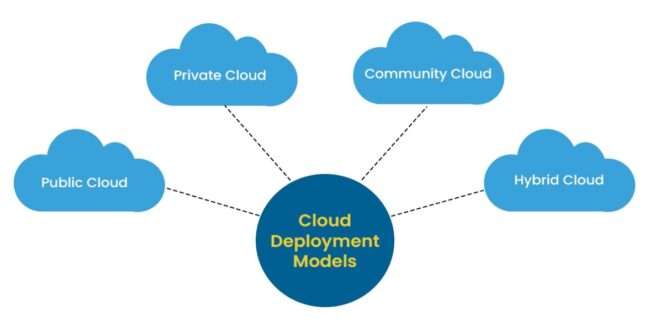
- Introduction to Cloud Computing
- Public Cloud
- Private Cloud
- Hybrid Cloud
- Community Cloud
- Cloud Service Models
- Benefits of Cloud Computing
- Choosing the Right Cloud Type
- Cloud Computing and Its Impact on Digital Transformation
- Security and Compliance in Cloud Computing
- Emerging Trends in Cloud Computing
- The Role of Cloud Computing in Business Continuity and Disaster Recovery
- Conclusion
Introduction to Cloud Computing
Cloud computing has revolutionized how organizations and individuals access, manage, and store data. With the growing need for flexible, scalable, and cost-effective IT resources, Cloud Computing Course has emerged as a game-changer in the digital era. Understanding the different types of cloud computing is essential to choosing the right solution for your needs. In this blog, we’ll explore the main types of cloud computing, their services, and how they benefit businesses and individuals. Cloud computing refers to the delivery of computing resources such as storage, processing power, and applications over the internet (“the cloud”). Rather than relying on local servers or personal devices, cloud computing enables users to access services and data remotely, usually on a pay-as-you-go basis. Cloud computing has several distinct advantages, including reduced infrastructure costs, increased scalability, flexibility, and accessibility. To best leverage these benefits, it’s crucial to understand the different types of cloud computing that are available, each offering unique features suited to various business and personal needs.
Start your journey in Cloud Computing by enrolling in this Cloud Computing Online Course .
Public Cloud
The public cloud is the most common and widely adopted cloud model. It is owned and operated by third-party service providers (such as Amazon Web Services, Microsoft Azure, or Google Cloud), who deliver computing resources like servers, storage, and applications to the general public over the Internet.
Key Characteristics:- Ownership: The cloud infrastructure is owned and managed by a third-party provider.
- Scalability: Public clouds offer virtually unlimited scalability, allowing users to increase or decrease resources as needed.
- Accessibility: Users can access public cloud resources from anywhere with an internet connection.
- Cost: Public clouds are typically cost-effective, as the costs are shared among many users (multi-tenant).
Use Cases:
- Small businesses or startups that require cost-effective IT infrastructure.
- Websites or applications that need to scale resources quickly to handle fluctuating demand.
- Development and testing environments for software developers.
Examples:Amazon Web Services (AWS),Microsoft Azure, Google Cloud Platform (GCP)
Private Cloud
A private cloud is a Cloud Computing Skills for Career Growth used exclusively by one organization. Unlike public clouds, private clouds can be hosted either on-premises or by a third-party provider, but the infrastructure is dedicated to that organization. Private clouds offer greater control, security, and customization compared to public clouds.
Key Characteristics:- Ownership: Private clouds can be owned and operated by the organization or a third-party provider.
- Security: Private clouds provide enhanced security, as resources are not shared with other organizations.
- Customization: Organizations can customize the private cloud infrastructure to meet specific needs and compliance requirements.
- Cost: Private clouds can be more expensive due to the dedicated resources and infrastructure.
Use Cases:
- Large enterprises with strict security and regulatory requirements (e.g., finance, healthcare).
- Organizations that need complete control over their infrastructure.
- Companies with high-performance computing needs.
Examples:VMware vSphere, OpenStack (used for creating private cloud environments)

Hybrid Cloud
The hybrid cloud model combines elements of both public and private clouds. It allows data and applications to be shared between the two environments, enabling businesses to leverage the benefits of both while maintaining greater control over sensitive data and workloads.
Key Characteristics :- Combination of Cloud Types:Hybrid clouds integrate public and private cloud infrastructures.
- Flexibility: Organizations can move workloads between public and private clouds as demand or requirements change.
- Cost Efficiency: Hybrid clouds offer the ability to optimize costs by running workloads on public clouds while keeping sensitive data on private clouds.
- Scalability: Hybrid clouds allow organizations to scale workloads easily by tapping into the public cloud when needed. Use Cases:
- Businesses with fluctuating workloads need to balance cost and security.
- Organizations that need to store sensitive data in a private cloud while running less critical applications in a public cloud.
- Large enterprises undergoing digital transformation and seeking a balance between legacy systems and cloud applications.
- Shared Resources: Community clouds are shared by multiple organizations that have common requirements.
- Collaboration: Ideal for collaboration among organizations within the same sector or with similar objectives.
- Security & Compliance: Community clouds often meet the specific regulatory or compliance needs of the organizations involved.
- Government agencies, research institutions, and healthcare organizations need to comply with Security Challenges in Cloud Computing .
- Groups of businesses that share infrastructure but require secure collaboration.
- Educational institutions or non-profit organizations with similar needs and goals.
- Examples: Amazon EC2, Microsoft Azure, Google Compute Engine
- Ideal For: Organizations that need to build custom applications or host workloads without managing physical hardware.
- Examples: Microsoft Azure App Service, Google App Engine, AWS Elastic Beanstalk
- Ideal For:Developers who want to focus on coding and app development without managing servers or infrastructure.
- Examples: Google Workspace, Microsoft 365, Salesforce
- Ideal For: Businesses and individuals who need ready-to-use software applications without the need for installation or management.
- Public Cloud: Ideal for businesses with variable workloads or small businesses that need cost-effective IT resources.
- Private Cloud: Best for organizations that require high security, compliance, and control over their infrastructure.
- Hybrid Cloud: Suitable for businesses with fluctuating demands and the need for a balance between cost efficiency and control.
- Community Cloud: A great option for organizations in the same industry or sector that need to collaborate securely and meet shared compliance requirements.
- Edge Computing Decentralizing data processing by moving it closer to the source, reducing latency, and improving real-time data analysis.
- Serverless Computing: Enabling developers to build and deploy applications without managing servers, leading to cost savings and improved efficiency.
- AI and Machine Learning Integration: Cloud-based AI services empower businesses to harness predictive analytics, automation, and intelligent decision-making.
- Sustainability in Cloud Computing: Cloud providers are adopting green computing practices by optimizing energy consumption and using renewable energy sources to reduce their environmental impact.
Examples: AWS Outposts (extends AWS services to on-premises environments), Microsoft Azure Stack (brings Azure services to private data centers).
Gain in-depth knowledge of Cloud Computing by joining this Cloud Computing Online Course now.
Community Cloud
A community cloud is a cloud infrastructure shared by several organizations with similar interests, goals, or compliance requirements. Community clouds are often used by organizations in specific industries, such as government or healthcare, that require a shared cloud environment to collaborate while ensuring security and compliance.
Key Characteristics:Use Cases:
Examples:Cloud-based collaboration tools for government agencies, Healthcare-focused cloud environments to share medical data
Cloud Service Models
In addition to the deployment models (public, private, hybrid, and community), cloud computing offers different service models, each providing a different level of control, management, and responsibility.
Infrastructure as a Service (IaaS)
IaaS provides virtualized computing resources over the internet. It offers the most basic level of cloud service, providing users with Cloud Computing Platforms and Services , such as virtual machines, storage, and networking.
Platform as a Service (PaaS)
PaaS provides a platform that allows developers to build, deploy, and manage applications without worrying about the underlying infrastructure. PaaS includes tools and services for application development, such as databases, development frameworks, and middleware.
Software as a Service (SaaS)
SaaS delivers fully functional software applications over the internet. With SaaS, users don’t need to worry about installation, maintenance, or infrastructure, as the software is managed by the service provider.
Aspiring to lead in Cloud Computing? Enroll in ACTE’s Cloud Computing Master Program Training Course and start your path to success!
Benefits of Cloud Computing
Cloud computing offers a wide range of advantages, including, Cost Efficiency, Scalability, Flexibility, Remote Access and Security. Reduce upfront capital expenditure by shifting to a pay-as-you-go pricing model. Easily scale resources up or down based on demand. Cloud Computing Course allow businesses to quickly adapt to changing needs and requirements. Access cloud resources from anywhere with an internet connection, enabling remote work and collaboration. Many cloud providers offer strong security measures, including encryption, firewalls, and compliance certifications.

Choosing the Right Cloud Type
Selecting the right cloud type depends on your organization’s specific needs, security requirements, and budget. Here are some key considerations:
Cloud Computing and Its Impact on Digital Transformation
Cloud computing has transformed how businesses and individuals utilize IT resources, enabling greater efficiency, cost savings, and scalability. The rapid adoption of cloud-based solutions has paved the way for digital transformation across industries. Organizations can now leverage advanced technologies such as artificial intelligence (AI), big data analytics, and the Internet of Things (IoT) to enhance operations and customer experiences. By integrating cloud computing into their digital strategies, companies can drive innovation, improve agility, and stay competitive in the digital economy.
Security and Compliance in Cloud Computing
One of the primary concerns when adopting cloud computing is security and compliance. Organizations must ensure that sensitive data and critical workloads are protected against cyber threats and unauthorized access. Guide to Cloud Security offer various security measures, including encryption, firewalls, multi-factor authentication, and compliance certifications (such as ISO 27001 and GDPR compliance). However, businesses must also implement robust security policies, such as access controls, regular security audits, and employee training to minimize vulnerabilities. Additionally, compliance with industry regulations (such as HIPAA for healthcare or PCI-DSS for payment processing) is essential to maintaining trust and legal adherence.
Preparing for Cloud Computing interviews? Visit our blog for the best Cloud Computing Interview Questions and Answers!
Emerging Trends in Cloud Computing
Cloud computing continues to evolve, bringing new trends that shape the future of IT infrastructure. Some of the key emerging trends include:
The Role of Cloud Computing in Business Continuity and Disaster Recovery
Cloud computing plays a crucial role in ensuring business continuity and disaster recovery. Traditional IT infrastructure often requires significant investment in backup and Essential Cloud Computing Tools and Beyond. However, cloud-based disaster recovery (DR) solutions provide cost-effective, scalable, and automated backup mechanisms to protect data and applications from failures, cyberattacks, and natural disasters. Cloud providers offer backup-as-a-service (BaaS) and disaster-recovery-as-a-service (DRaaS) to enable businesses to recover quickly and minimize downtime. By leveraging cloud computing, organizations can enhance resilience, maintain operations during crises, and safeguard critical data.
Conclusion
Cloud computing has revolutionized how businesses and individuals access and manage IT resources. By understanding the different types of cloud computing — public, private, hybrid, and community clouds — organizations can make informed decisions about which model suits their needs best. Additionally, with the various cloud service models (IaaS, PaaS, SaaS), companies can select the most appropriate service that aligns with their goals, whether it’s managing infrastructure, developing applications, or using software solutions.As Cloud Computing Course continues to evolve, it remains a critical technology that empowers organizations to become more agile, cost-effective, and innovative. By choosing the right cloud model and service, businesses can enhance their operations and achieve long-term success in today’s digital-first world.





